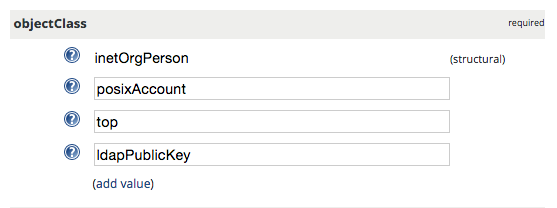Setting up OpenLDAP server with OpenSSH-LPK on Ubuntu 14.04
This post documents how to set up a secure OpenLDAP server that is able to make OpenLDAP client servers accept authorized SSH access requests from users. The following steps assume the OpenLDAP server (slapd) and phpLDAPadmin are installed as referenced in the initial setup.
Instructions and references
- Initial setup
- OpenSSH-LPK and ssh-ldap-pubkey (on LDAP clients)
- Force authentication
- Secure LDAP with SSL/TLS
Understanding cn=config (LDAP database)
The default installation of OpenLDAP in recent versions of Ubuntu uses the new runtime configuration (RTC) system or olc (OpenLDAP Configuration). This installation uses cn=config (the LDAP database) for configuration rather than the old style slapd.conf.
Schemas
The schemas can be imported dynamically into cn=config database, without restarting slapd. The schemas to be imported can placed in /etc/ldap/schema.
The following schema in ldif format will be used and discussed in the subsequent sections:
- openssh-lpk.ldif
- ldap_disable_bind_anon.ldif
- ssl.ldif
Importing openssh-lpk scheme
ldapadd -Y EXTERNAL -H ldapi:/// -f openssh-lpk.ldif
where openssh-lpk.ldif is:
dn: cn=openssh-lpk,cn=schema,cn=config
objectClass: olcSchemaConfig
cn: openssh-lpk
olcAttributeTypes: ( 1.3.6.1.4.1.24552.500.1.1.1.13 NAME 'sshPublicKey'
DESC 'MANDATORY: OpenSSH Public key'
EQUALITY octetStringMatch
SYNTAX 1.3.6.1.4.1.1466.115.121.1.40 )
olcObjectClasses: ( 1.3.6.1.4.1.24552.500.1.1.2.0 NAME 'ldapPublicKey' SUP top AUXILIARY
DESC 'MANDATORY: OpenSSH LPK objectclass'
MAY ( sshPublicKey $ uid )
)
Forcing authentication
By default, OpenLDAP allows anonymous query from any client servers. You may want to enable authentication so that only authenticated clients are able to query the server:
ldapadd -Y EXTERNAL -H ldapi:/// -f ldap_disable_bind_anon.ldif
where ldap_disable_bind_anon.ldif is:
dn: cn=config
changetype: modify
add: olcDisallows
olcDisallows: bind_anon
dn: cn=config
changetype: modify
add: olcRequires
olcRequires: authc
dn: olcDatabase={-1}frontend,cn=config
changetype: modify
add: olcRequires
olcRequires: authc
Securing LDAP with TLS
Install the package that provides certtool:
apt-get install gnutls-bin
Generate new certificate (self-signed) and key:
mkdir -p /etc/ldap/gnutls cd /etc/ldap/gnutls certtool --generate-self-signed --load-privkey ldap.gnutls.key --outfile ldap.gnutls.crt
Fix permission of private key:
chmod +r /etc/ldap/gnutls/ldap.gnutls.key
Importing SSL schema
ldapmodify -Y EXTERNAL -H ldapi:/// -f ssl.ldif
where ssl.ldif is:
dn: cn=config
changetype: Modify
add: olcTLSCertificateKeyFile
olcTLSCertificateKeyFile: /etc/ldap/gnutls/ldap.gnutls.key
-
add: olcTLSCertificateFile
olcTLSCertificateFile: /etc/ldap/gnutls/ldap.gnutls.crt
-
add: olcTLSCipherSuite
olcTLSCipherSuite: NORMAL
-
add: olcTLSCRLCheck
olcTLSCRLCheck: none
-
add: olcTLSVerifyClient
olcTLSVerifyClient: never
Enabling LDAPS
By default, only ldap and ldapi (Unix domain socket) are enabled. Make ldap listen to only 127.0.0.1 and keep the latter so that you can run ldap utilty commands against ldapi:/// without providing credentials if working on the same server.
Edit /etc/default/slapd and ensure the following line:
SLAPD_SERVICES="ldap://127.0.0.1:389/ ldaps:/// ldapi:///"
Configuring /etc/ldap/ldap.conf
Edit /etc/ldap/ldap.conf and add the following line:
TLS_REQCERT never
Testing the above LDAPS config
ldapsearch -d 9 -D "cn=Bob,ou=users,dc=example,dc=com" \
-w password -b "dc=example,dc=com" -H "ldaps://ldap.example.org" "objectClass=*"
Customizing phpLDAPadmin config and templates
You can customize template configurations (/etc/phpldapadmin/config.php).
For example, change the base uid and gid to a greater value:
$servers->setValue('auto_number','min',array('uidNumber'=>3000,'gidNumber'=>3000));
Add
$config->custom->appearance['theme'] = 'tango';
You can also customize templates for various components, for example, POSIX account:
- /etc/phpldapadmin/templates/creation/posixAccount.xml
Customize themes and styles:
- /usr/share/phpldapadmin/lib/page.php
- /usr/share/phpldapadmin/htdocs/css/tango/style.css
Adding a user with SSH public key in phpLDAPadmin
First, create a user with the “Generic: User Account” template. Then, go to the “objectClass” attribute section, click “add value”, and choose the “ldapPublicKey” attribute. After you submit, go back to the user edit page, click “Add new attribute” on the top part, and choose “sshPublicKey”, paste the public key into the text area, and finally click “Update Object”.

